Extended growth: the telescopic boom market
18 April 2022
Strong demand. Healthy backlog. Increased utilization. These are just a few of the descriptors manufacturers have made regarding the telescopic boom lift market across North America. There’s no denying it – this well-established sector is, well, booming.
“This past year has seen a significant rebound for telescopic booms across all North American regions,” says Corey Connolly, senior product manager for Skyjack. “While some areas may not be back to pre-2020 levels, almost all major regions saw demand for telescopic booms increase 50 percent in 2021 vs 2020.”
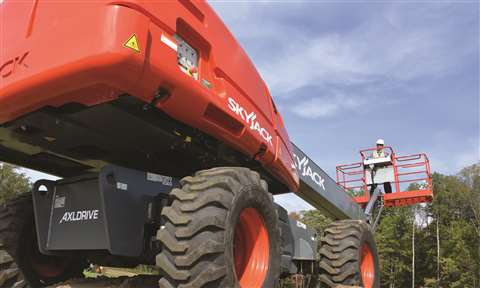 Photo: Skyjack
Photo: Skyjack
Skyjack, whose focus over the past few years has been updating and improving existing telescopic product lines, expects this momentum to continue, with Connolly noting utilization is expected to be high in all almost of the company’s regions as customers continue to field demand.
“Strong rental activity has created strong demand for all class sizes,” Connolly says. “Looking at this demand, our outlook is very positive.”
The same can be said for Haulotte, which says it is entering 2022 with a healthy backlog.
“Our customers are beginning to return to a predictable purchasing pattern as machine fleets age,” says Paul Jensen, Haulotte product manager, Americas. “As ordering paces increase, we are seeing growing interest in our latest telescopic boom, the HT 46 RTJ.”
Jensen notes telescopic booms in this size class are frequently seen in higher numbers on a jobsite due to the units’ compact footprint. Haulotte launched the HT 46 RTJ in 2020, right before the pandemic shut down the world-wide economy.
“The machine was well-received at the time,” he says, “and now that we see a rebound in the economy, it’s really taking off.”
Haulotte previously offered customers a 45-foot RT telescopic boom, but the company opted to design and produce a completely new model to address this market.
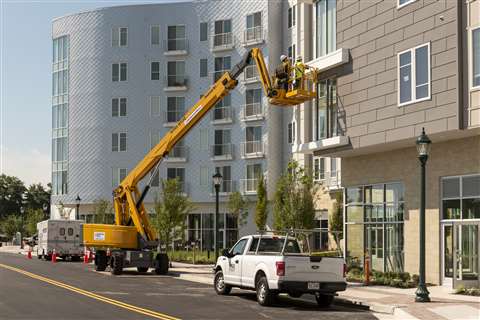 Photo: Haulotte
Photo: Haulotte
The brand-new boom features all of Haulotte’s newest innovations like dual load capacities, the Activ’Shield secondary guarding system and Activ’Lighting System for improved visibility in low-light conditions.
“But deeper, in the heart of the machine, we see even more improvements,” Jensen says. “A new, right-sized diesel engine is coupled with a mechanical axle drive train. That means less pollution, less fuel consumption, less noise, and all the same performance of the older, larger power plants. In addition to saving money on fuel, maintenance costs decrease with easier access to all components and routing that protects hoses and cables from damage caused by friction or pinching.”
Driving demand
JLG notes that despite the telescopic boom lift market being quite mature – and the applications these units serve being well-established – a number of factors are contributing to this sector’s healthy status.
“Boom lifts, in general, are common jobsite tools, and we continue to see strong demand for all models, including telescopic units,” says Nate Hoover, JLG’s director of product management. “Demand is being driven by replacement cycles, fleet growth and an increase in construction and construction-related activities – not only in North America, but all around the globe.”
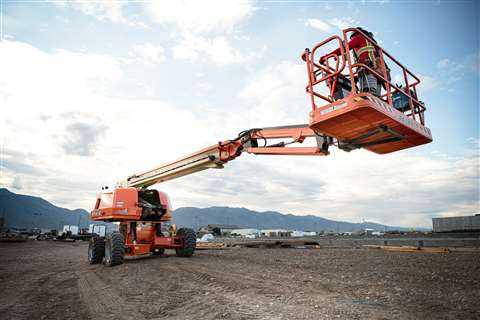 Photo: JLG
Photo: JLG
According to Hoover, demand for telescopic booms does vary by region, but despite regional differences, there are some common themes.
“There is a large focus on productivity and enabling equipment users to do more with less, in tighter spaces, under stringent time and budget demands in a manner that is minimally disruptive to the environment,” Hoover says. “Technology and the speed at which it’s advancing plays a role in achieving this. For example, we are seeing a lot of interest in highly versatile machines. The first of its kind JLG 670SJ self-leveling boom lift is a good example of this.”
The 670SJ offers the typical standard features of a telescopic boom lift, but it also has the ability to self-level on slopes up to 10-degrees. Hoover says in many instances, this eliminates the need for cribbing and grading of the ground before work can start up.
“There are situations that lead to boom lift operators putting in a lot of extra effort to get the work done,” Hoover says. These include having to constantly reposition the lift, preparing the grounds, renting a larger machine than what’s necessary to access the work at hand, using multiple machines to accomplish tasks and so on.
“All of these practices are time-consuming and impede productivity,” Hoover says. “These are the scenarios that drive innovation at JLG; we look for real jobsite pain points and design innovative products that eliminate them.”
JLG’s 670SJ was purpose-built with new technologies that the company feels will truly transform how people work at height.
“The 670SJ self-leveling boom lift’s technology can save a significant amount of time and money,” Hoover says. “The unit’s technology allows 670SJ models to work closer to buildings with less positioning while providing operators with comfortable stability when operating in rugged conditions, all of which lead to greater productivity.”
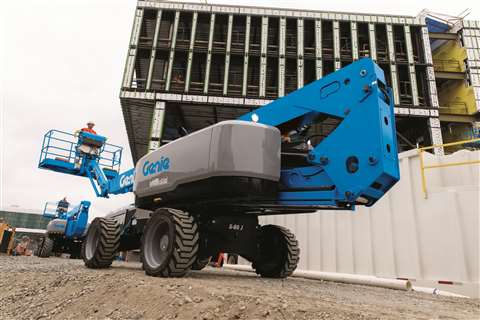 Photo: Genie
Photo: Genie
Taking it all in stride
Over at Genie, Simone Manci, Genie applications engineer, echoes the market’s positivity, but also addresses the elephant in the room.
“Telescopic booms continue to see increasing utilization rates and strong demand,” Manci says. “The challenge is availability, as, across the industry, we continue to feel the impact of a constrained supply chain.”
Matthew Elvin, Snorkel CEO, agrees. “Demand for telescopic booms is strong and has almost returned to pre-pandemic levels. The challenge, however, are the supply chain constraints which are severely restricting product availability.”
And the same can be said for Manitou, who notes high-demand coupled with supplier shortages has pushed the need for equipment to an all-time high.
“Customers want machines on a first-come, first-serve basis,” says Ken Forbes, product manager of Manitou MEWPs and forklifts.
But Forbes, and his colleague Jose Orozco, Manitou regional training specialist - western region, note that the post-Covid construction economy is forecasted to be “very promising.”
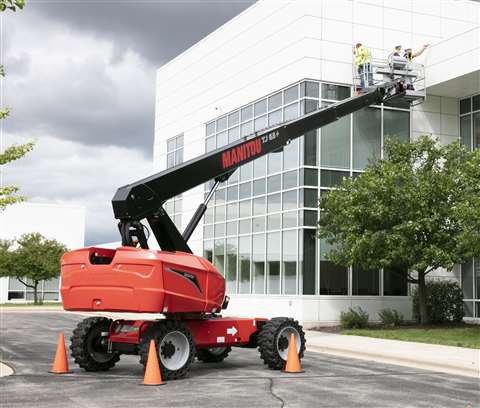 Photo: Manitou
Photo: Manitou
“For the U.S., the American Institutes of Architects’ Consensus Construction Forecast predicts non-residential construction will grow 4.6 percent in 2022,” Forbes says. “Nine percent growth is expected in the residential sector according to Oxford Economics. This will directly impact the number of booms sold directly and for the rental industry.”
Biggest trends
Electrification and capacity are two of the market’s hottest topics when it comes to telescopic booms.
“Electrification isn’t new, but it’s still a very relevant subject because demand is accelerating for quality, productive and clean equipment,” says Manci. “Globally, regulations are driving an increase in interest in hybrid and electric equipment, especially in countries and locations that have enacted jobsite emissions standards and where emissions levels are being monitored throughout the duration of a construction project.”
When asked what Genie has up its sleeves regarding new, electric units, Manci keeps a tight lid on Genie’s developments.
“While I can say that we will have some exciting news coming early this year about an addition to our boom lineup, we’re not ready to talk about it just yet,” Manci teases. “But stay tuned for news coming from Genie later this year.”
Snorkel also says green machines and increased lifting capacities are the top two trends for this sector.
“Electrification of traditional internal combustion equipment is continuing to gather pace across the aerial industry, as well as in all segments of construction equipment,” Elvin says. “In late 2021, Snorkel introduced its first lithium-electric, 46-foot articulated boom lift, and is continuing to explore how this technology can be transferred to other similar sized units, including its telescopic booms.
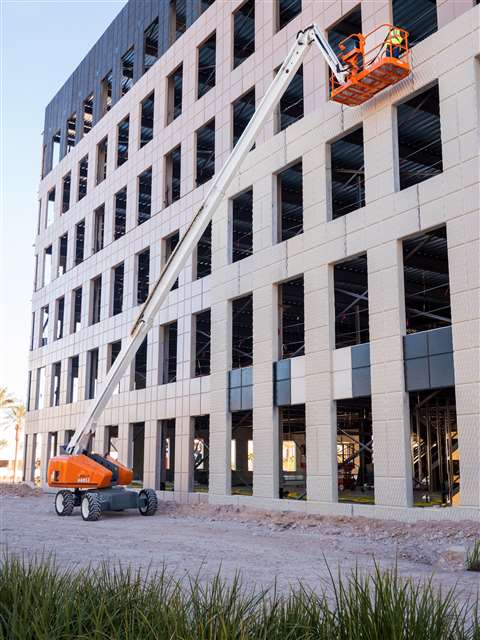 Photo: Snorkel
Photo: Snorkel
“The electrification of larger telescopic booms continues to be explored, however, it is subject to the capabilities of the battery technology to match or exceed the performance of the diesel version, while also remaining affordable.”
For JLG, keeping a close eye on battery technology is also key.
“We are closely watching and investing in battery technology to continue to advance JLG products and offer industry-leading electrified solutions,” says Hoover. “For JLG, electrification is not new — in fact, many JLG products have been electrified for more than 20 years.
“Today’s demand for more environmentally friendly products, combined with the increasing complexity of internal combustion engines and the associated costs are working to accelerate the adoption of electric products, including boom lifts.”
JLG says at a high level, the company is seeing increased interest in electrified solutions across the access industry, and countries with more stringent emissions regulations and applications in noise-sensitive environments are at the forefront.
“That said, one of the biggest challenges threatening adoption as more equipment goes electric is how these machines will be charged onsite by users, particularly in the early stages of construction or in remote locations where power is not readily available,” Hoover says. “Right now, the big gap in the electrification eco-system is the charging infrastructure.”
Go big or go home
The ability to lift more – both product and people – is also a major factor for OEMs right now.
According to Genie, higher capacities are being requested across jobsites as productivity and efficiency become more important, particularly in places where labor is hard to find or where labor costs are going increasing.
“Higher capacity means you can take more material and tools to height at one time, which means fewer lift cycles. This saves time and, therefore, money,” Manci notes. “Take, for example, glass installation. Our Genie Xtra Capacity booms are popular choices for glass installation because they offer a restricted capacity of 1,000 pounds and an unrestricted capacity of 660 pounds”
Snorkel is experiencing the need for larger lifting capacities, as well.
“We expect to see new models launched addressing this as a standard feature,” Elvin says. “While reaching higher heights will always be a focus of the industry, there are design challenges to overcome to go larger. For example, the Snorkel 2100SJ meets global road transport regulations in terms of transport width and length. If self-propelled booms become much larger, the ability to transport the boom between projects is likely to become more difficult and costlier.”
Data points
Sinoboom, which launched the TB660J Plus boom in late 2021 – its first for the North American market – says it is seeing consistent growth in the telescopic market as rental demand remains high after the initial demand slowdown from the pandemic.
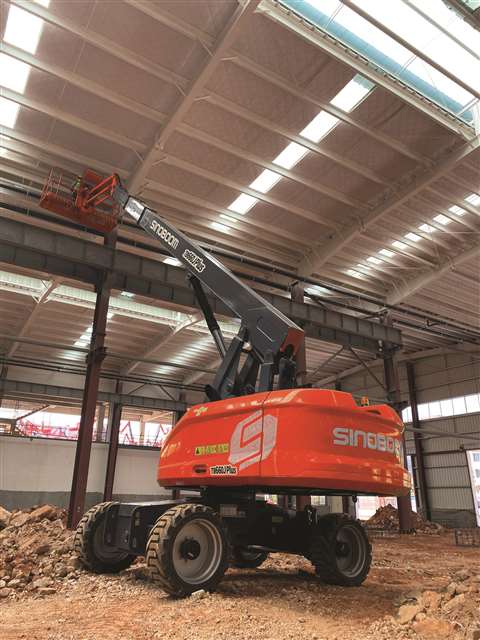 Photo: Sinoboom
Photo: Sinoboom
“Almost all regions are seeing growth, but we see potential in the Midwest region due to the rise of new manufacturing and logistics facilities,” says Trevor Collins, service manager, Sinoboom North America. “We expect to see continued high demand for 65- and 85-foot classes of telescopic booms due to the product availability issues faced by multiple manufacturers from global supply constraints. Customers are playing catch up on new equipment for their fleets.”
Sinoboom notes that technology advancements – not only with its own equipment but other manufacturers, as well – will continue to shape machine design and usage.
“We continue to see investments in technology being incorporated into telescopic booms,” Collins says. “Adding new technology to improve fleet ROI will continue to be at the forefront.”
One of the significant changes, Sinoboom says, is the increased use of telematics and fleet monitoring solutions.
“These applications offer rental yards and customers visibility on their machines that had not previously been available without going to the jobsite,” Collins notes. “Telematics solutions provide many resources to all aspects of equipment ownership and equipment rental.
“The implementation of new technology in MEWPs allows clearer communication with telematics devices that give users and owners better insight into historical and current operations while providing an outlook to future equipment needs such as routine maintenance.”
Haulotte also believes telematics will continue to have a big impact on telescopic booms.
“I’m excited to see how telematics data will change machine design over the next few years,” says Jensen. “Having real insight into how machines are used, every day, under all conditions, will help guide design decisions to make sure we get a future machine that meets real world needs.
“This information will help drive the quickly growing electrification trend helping focus advancements on features that have the biggest impact on the safety and productivity on jobsites.”
STAY CONNECTED



Receive the information you need when you need it through our world-leading magazines, newsletters and daily briefings.
CONNECT WITH THE TEAM








